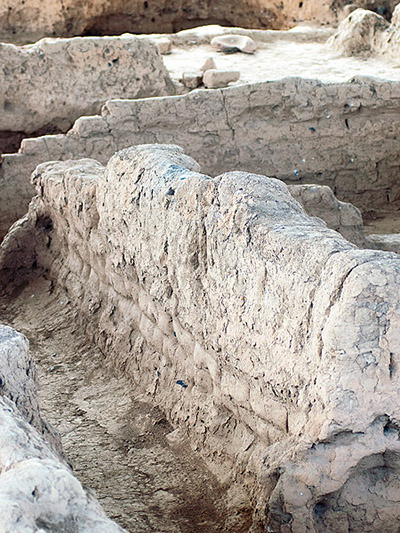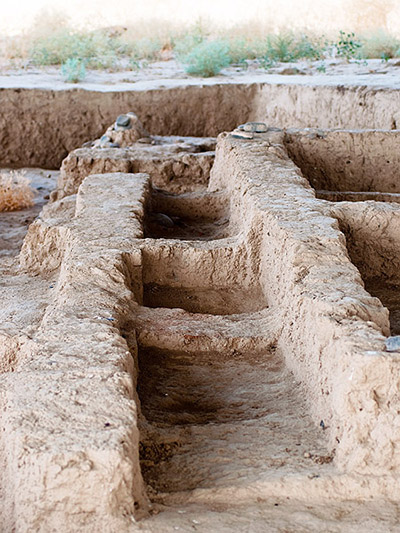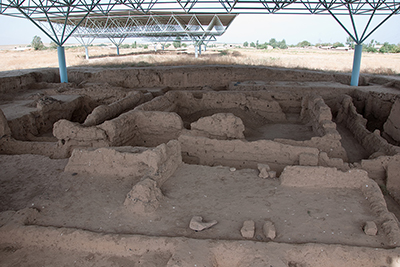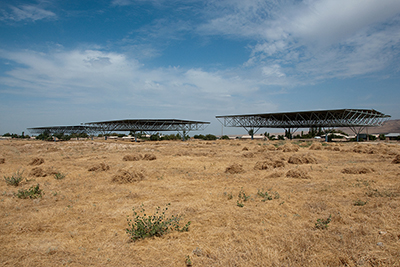55 Centuries of Sarazm – The Oldest Settlement of Farmers and Artisans in Central Asia
The beginning of the land

Fifteen kilometers west of the ruins of old Panjakent, near the Tajik-Uzbek border, there are three villages with a predominantly Uzbek population: Gurach, Sohibnazar, and Avazali. They grow vegetables, cultivate rice fields, and until recent times, plant tobacco in the fields adjacent to the villages.
This area is not much different from hundreds of other villages in Tajikistan, except for one thing: the 100 hectares of land on which these villages are situated, extending all the way to Zeravshan, was once the site of the largest early agricultural settlement in Central Asia dating back to the late Eneolithic (Copper-Stone Age) and Bronze Age. At that time, people did not yet use iron.
This place is called Sarazm. About 5,500 years separates the modern residents of the Sarazm jamoat from the first inhabitants of the settlement, who arrived on the left bank of the Zeravshan from the south of the present-day Turkmenistan in the fourth millennium B.C, and having mixed with the indigenous tribes of collectors, hunters, and anglers, formed a small settlement of farmers.
By this time, the first city-states of Sumer and Harappa had already existed in the south of modern Iraq and in the Indus River Valley. Sarazm is the same age as these first agrarian civilizations.
There are three etymological interpretations of the word “Sarazm”:
- Sarsabz, i.e. “sari sabza” – “green beginning”. Looking east from Sarazm to towards the mountains, one sees the beginning to a green valley.
- From an Arabic word Sarrazm, which means “beginning of the battle, fight”. Sarazm marks the beginning of the land of Kuhistan, where the inhabitants of the Zeravshan met their enemies and fought the first battle.
- The word Sarazm in the Sogdian language means “sari zamin”, i.e. “the beginning of the land”. Sarazm is located in a place where the valley can be divided into flat and mountainous parts. The word “zamin” refers to the land that stretches for several hundred kilometers to the west of the ancient settlement. There are no high mountains between this point and the Caspian and Aral seas.
The third version is most prevalent among historians. We do not know what the Sarazmians themselves or the people and tribes surrounding them called this place. During that time, there was no written language in territory of Central Asia, and histories also do not know what language the Sarazmians spoke.
Bronze, even more expensive than gold

The discovery of this Bronze Age settlement began with a small bronze axe. In 1976, a resident of the Gurach village, World War II veteran Ashurali Tailonov, informed Abdullo Isakov, an employee of the nearby Panjakent archaeological base, about a finding that he made six years ago.
Tailonov had found a bronze axe-adze while digging. Similar hoe axes are still used by Tajik farmers, although they are made of iron. By this time, Isakov was well-known in scientific circles as the archaeologist who had discovered the citadel and palace of the ancient rulers of Panjakent.
Tailonov showed Isakov the place where he made the discovery, and archaeologists began several trial excavations in the settlement. Digging at a depth of 1-1.5 meters, they discovered several layers of ancient construction: the walls and corridors of residential buildings, public granaries, workshops, and religious structures with round altars characteristic of the Bronze Age – the oldest Pre-Zoroastrian monument of the fire cult. Since 1977, regular excavations continue on this site – the largest in Central Asia. The city appears to have been inhabited since the 35th century B.C. until the 19th century B.C., when it was abandoned.
Four eras of Sarazm

Archaeologists divide the history of Sarazm into 4 periods: from the beginning of primitive agriculture, to the transformation of the settlement into a center of ancient metallurgy and metal processing, and finally to the subsequent decline of production in the last period of the settlement’s life.
Other area residents also found stone or bronze objects, ostracons (small pieces of pottery or stone with writing on them), and fragments of ceramics, marble dishes and bone products near theirs home or gardens. Many exhibits from the Sarazm collection were found by locals and subsequently handed over to scientists.
However, the archaeologists themselves also discovered many interesting objects and structures created by the ancient settlers. By the third period of the settlement’s life, approximately in the 3rd millennium B.C. when Sarazm reached the peak of its development, the ancient Sarazmians extracted and processed non-ferrous metals, forged copper, casted bronze, and made knives and spears, axes, and chisels for finer work on metal, stone, and bone.
The preserved remains of clay stoves confirm that pottery production also developed in the city. The most ancient ceramics are similar in painting to samples from agricultural oases in southern Turkmenistan. Later, Sarazmian masters developed their own style of painted ceramics. Pottery was made mainly by hand, connecting strips of clay. This technology was still used until recently among Tajik mountain potters.
Although traces of a potter’s wheel were discovered in the settlement, it was not widely used. Residents specialized in the production of stone and metal products.
Archaeologists discovered finished and semi-finished products made from turquoise from Ferghana and lapis (a deep blue semi-precious stone), mined in the mountains of. The residents of Sarazm actively engaged with the people and tribes of Central Asia, Afghanistan, Iran, and even India.
In a rich burial site, bracelets made of shells were found that could have been brought from the shores of the Arabian Sea or the Indian Ocean. Carnelian (a red-brown mineral) jewelry was brought from the cities of Harappan (Indus) Civilization. It is unlikely that these items came from trade, because money as a means of exchange had not yet been invented.
From silicon to copper

It is not known for certain when ancient humans discovered that they could shape and use metal tools. Presumably, it occurred in the Neolithic Era, when craftsmen could already process stone and create tools and weapons from flint. These processes required well-honed skills and abilities. Flint is a strong but fragile rock, and one had to know how to hit stone with another stone in order to construct a tool of the needed shape and sharpness.
Perhaps one of the ancient people noticed that some pieces of stone do not crack when they are hit, but instead are deformed and from friction heat up and become more ductile. This is one explanation of how people discovered the properties of metal ore.
First, people mastered the technology of cold forging. They struck a piece of copper with a stone and shaped it. The finished product was soft and quickly became blunt, but was still better than a flint scraper.
After craftsmen built the first primitive forge, the ancient metallurgists began to melt and forge hot metal, experimenting with alloys. By adding tin and arsenic to soft copper, bronze was created – a more durable metal and stronger metal. Thus began the Bronze Age. In Sarazm, archaeologists found numerous copper and bronze objects from copper and bronze, as well as stone tools, pestles, and hammers for processing metal ore.
Among the findings were bronze spears, knives and daggers, spearheads, mirrors and pins, fishing hooks, and tools for working with stone. However, Sarazmians did not need so many weapons. They were a peaceful people and judging from the lack of defensive walls and fortifications in the city, did not often suffer from enemy raid. The walls of houses inside the settlements were thin and could not withstand a siege. Most of these items were likely for exchange with other pastoral and agricultural tribes.
The Princess of Sarazm
One of the most famous findings from the settlement is a rich burial ground. Among other burials, archaeologists found the skeleton of a 36 or 37-year-old woman inside a large circular ring, 15 meters in diameter and made of stones. Inside the burial ground there were also several additional single, paired, and collective graves.
Some of the graves had objects, such as a marble dish, buried next to the skeletons. Although some were buried with nothing, the richest grave was lavishly decorated with many objects. The woman’s body was covered with a veil richly embroidered with beads of lapis and white limestone, and she became known as the “Princess of Sarazm”.
Archaeologists have counted more than 10,000 of these beads, which were painstakingly and thoroughly crafted. Gold beads were found at the head of the grave of the “Sarazm Princess”, apparently threaded through the hair of the deceased. Two massive bracelets carved from sea shells were found on her hands, and a copper mirror and a statuette of a female deity made of unburned clay were placed next to her.
A whole carcass of a ram was placed 50 centimeters from the body. This burial is dated to the first period of the settlement’s existence, known as “Sarazm I” or 3,500-3,000 B.C. For comparison, the first Egyptian pyramid—the Step Pyramid of Djoser—was built around 2,800 B.C.
The burial ground in Sarazm was discovered at the level of the first layer of the Bronze Age monument. In later periods of the settlement, residential and utility rooms were built over the necropolis. Some excavations showed signs of all four layers of the settlement’s existence, while in others, only one.
Throughout the entire period of archaeological work, several burial grounds were discovered, although not enough to support a settlement which existed for almost 1,600 years. This means that either the necropolis was located outside of Sarazm or archaeologists have yet to find it.
The mystery of the Sarazmians
The “Princess of Sarazm” gave researchers valuable knowledge into the lives and culture of the Sarazmians. For instance, her lavish burial shows that in the society of the late Eneolithic and Bronze Age, property, and social inequality, and class systems already existed. She was buried with the most valuable objects from that time period. Probably, she was the wife of a ruler, or may have been a ruler or priestess herself.
Little is known about the beliefs of the ancient inhabitants of Sarazm. Due to lack of written sources, we do not know anything about their religious beliefs or rituals. It is clear that people already believed in the existence of the afterlife, which they perceived as a continuation of the human world. Otherwise, why would they put in graves jewelry, mirrors, and dishes that were expensive and valuable to people.
People believed in the existence of evil and good spirits and in gods. This encouraged them to ask for patronage and protection through the ritual of sacrifice. The carcass of a ram, laid down with the deceased, was probably a payment to the other world. The remains of charred cereals and animal bones that were discovered in the altars could also be evidence of sacrifices.
In Sarazm, as in any other agricultural civilization, the cult of fertility, the deification of nature, and concept of Mother Earth was widespread. Phallic pestles for grinding ore, or grain grinders, statuettes of female deities with unnaturally large sexual features, are proof of this. The development of metallurgy and pottery led to a cult of fire, the fear of which was inherent in primitive man since the dawn of time.
The decline of Sarazm
In the fourth and last period of Sarazm’s history, the settlement declines—products that were discovered in the newer layers are not of the same high quality as before, the ceramics are not as picturesque, the settlement area is reduced, and people have migrated south to more fertile regions.
Scientists have advanced two theories on the decline of the settlement. The first suggests an invasion of pastoral tribes from the north, possibly by Aryans. The second theory is related to climate, and it hypothesis a period of drier weather and less precipitation, leading to a decrease in agricultural production.
Most historians are inclined to believe the second version. The climate became more humid again only from the first millennium B.C., during the Iron Age. By this point, Sarazm was already long forgotten and buried under a layer of soil and clay.
A Bronze Age village may not make a huge impression on a modern visitor. One will see only the remains of clay walls, stoves, and altars. However, even modern day Tajik villages can feature houses with mud walls. But only through study of this unique settlement of ancient farmers and artisans can we discover what life was like many centuries ago.
In 2010, Sarazm was included in the list of UNESCO World Heritage Sites. Six years prior, in 2004, the U.S. Embassy in Tajikistan, through the Ambassador’s Fund for Cultural Preservation, implemented a project to conserve the collections of the Sarazm Archaeological Museum in Panjakent at a cost of more than $19,000.
Thanks to this project, the Sarazm collection of ceramics, stone tools, and jewelry was preserved, and the museum renovated its facilities to provide adequate storage and support for the artifacts.
Bibliography
Bezenval, R. & Razzokov, A.I. The search for sources of raw materials and the settlement of Paleometal Epoch in the Upper Zeravshan Basin, Tajikistan.
Isakov, A.I. Sarazm. On the origins of early agriculture in Zeravshan Valley. Excavations of 1977-1983. Dushanbe, Donish, 1991
Isakov, A.I. A rich female burial from Sarazm.
Razzokov, F.A. (2016). Construction complexes of the ancient agricultural settlement of Sarazm in the IV-III millennium BC. Saint Petersburg.
Rasul-zade, T. Where the land began. Retrieved from https://fergana.agency/articles/109900/
Sarazm. In Wikipedia. Retrieved from https://ru.wikipedia.org/wiki/%D0%A1%D0%B0%D1%80%D0%B0%D0%B7%D0%BC



